Experimental Study on Physical Behavior of Fluidic Oscillator in a Confined Cavity with Sudden Expansion
Abstract
1. Introduction
2. Experimental Setup and PIV Measurement
3. Results and Discussion
3.1. Time-Averaged Results
3.1.1. Velocity Distribution
3.1.2. Q-Criterion Distribution
3.1.3. Velocity and Turbulence Fluctuation’s Profiles
3.1.4. Momentum Flux
3.2. Proper Orthogonal Decomposition (POD) Results
4. Conclusions
- Confinement of the external domain led to create two identical vortices at the lowest Re number and caused the jet to have a smaller spreading angle than the free external domain.
- For Re = 6440, a V-shaped pattern was created in the free external domain, but for the fully confined geometry, the presence of a vortex at the exit region of the fluidic oscillator prevented the formation of a periodic flow, and the jet bent toward it.
- For the fully confined geometry at Re = 10,730, the potential of the main jet tended to cope with the strength of the created vortices, and it was expected that by increasing the Re number, an oscillating pattern would be observed.
- A linear relation between the Reynolds number and the non-dimensional circulation ratio exists for the fully confined case. In contrast, this ratio for the free external domain is almost constant and independent from the Re number.
- For the fixed internal geometry, a linear relation between the Reynolds number and oscillation frequency leads to the Strouhal number, St = f Dh/Uj, being constant.
- POD analysis reveals the fact that for the fully confined case, the third mode was still energetic at Re = 6440, and the first three modes stood for the large coherent flow structures. However, for the free external domain, the first two modes were energetic and showed the periodic behavior of the oscillating flow.
- Phase-averaged analysis showed that for the fully confined case, although the jet was attached to the sidewalls, there was an oscillating pattern at its small oscillation area, with high frequency.
Supplementary Materials
Author Contributions
Funding
Conflicts of Interest
References
- Bouchet, G.; Climent, E. Unsteady behavior of a confined jet in a cavity at moderate Reynolds numbers. Fluid Dyn. Res. 2012, 44, 025505. [Google Scholar] [CrossRef]
- Villermaux, E.; Hopfinger, E.J. Self-sustained oscillations of a confined jet: A case study for the non-linear delayed saturation model. Phys. D Nonlinear Phenom. 1994, 72, 230–243. [Google Scholar] [CrossRef]
- Maurel, A.; Ern, P.; Zielinska, B.J.A.; Wesfreid, J.E. Experimental study of self-sustained oscillations in a confined jet. Phys. Rev. E 1996, 54, 3643–3651. [Google Scholar] [CrossRef] [PubMed]
- Kolšek, T.; Jelić, N.; Duhovnik, J. Numerical study of flow asymmetry and self-sustained jet oscillations in geometrically symmetric cavities. Appl. Math. Model. 2007, 31, 2355–2373. [Google Scholar] [CrossRef]
- Molloy, N.A.; Taylor, P.L. Oscillatory flow of a jet into a blind cavity. Nature 1969, 224, 488–490. [Google Scholar] [CrossRef]
- Cherdron, W.; Durst, F.; Whitelaw, J.H. Asymmetric flows and instabilities in symmetric ducts with sudden expansions. J. Fluid Mech. 1978, 84, 13–31. [Google Scholar] [CrossRef]
- Fearn, R.M.; Mullin, T.; Cliffe, A.K. Nonlinear flow phenomena in a symmetric sudden expansion. J. Fluid Mech. 1990, 211, 595–608. [Google Scholar] [CrossRef]
- Casarsa, L.; Giannattasio, P. Three-dimensional features of the turbulent flow through a planar sudden expansion. Phys. Fluids 2008, 20, 015103. [Google Scholar] [CrossRef]
- Panitz, T.; Wasan, D.T. Flow attachment to solid surfaces: The Coanda effect. AIChE J. 1972, 18, 51–57. [Google Scholar] [CrossRef]
- Kim, S.H.; Kim, H.D.; Kim, K.C. Measurement of two-dimensional heat transfer and flow characteristics of an impinging sweeping jet. Int. J. Heat Mass Transf. 2019, 136, 415–426. [Google Scholar] [CrossRef]
- Ghanami, S.; Farhadi, M. Heat transfer enhancement in a single-pipe heat exchanger with fluidic oscillators. J. Therm. Anal. Calorim. 2019, 140, 1107–1109. [Google Scholar] [CrossRef]
- Ten, J.S.; Povey, T. Self-excited fluidic oscillators for gas turbines cooling enhancement: Experimental and computational study. J. Thermophys. Heat Transf. 2019, 33, 536–547. [Google Scholar] [CrossRef]
- Wu, Y.; Yu, S.; Zuo, L. Large eddy simulation analysis of the heat transfer enhancement using self-oscillating fluidic oscillators. Int. J. Heat Mass Transf. 2019, 131, 463–471. [Google Scholar] [CrossRef]
- Zhou, W.; Yuan, L.; Liu, Y.; Peng, D.; Wen, X. Heat transfer of a sweeping jet impinging at narrow spacings. Exp. Therm. Fluid Sci. 2019, 103, 89–98. [Google Scholar] [CrossRef]
- Eghtesad, A.; Mahmoudabadbozchelou, M.; Afshin, H. Heat transfer optimization of twin turbulent sweeping impinging jets. Int. J. Therm. Sci. 2019, 146, 106064. [Google Scholar] [CrossRef]
- Mohammadshahi, S.; Samsam-Khayani, H.; Cai, T.; Kim, K.C. Experimental and numerical study on flow characteristics and heat transfer of an oscillating jet in a channel. Int. J. Heat Fluid Flow. 2020, 86, 108701. [Google Scholar] [CrossRef]
- Lacarelle, A.; Paschereit, C.O. Increasing the passive scalar mixing quality of jets in crossflow with fluidics actuators. J. Eng. Gas Turbines Power 2012, 134, 021503. [Google Scholar] [CrossRef]
- Mi, J.; Nathan, G.J.; Luxton, R.E. Mixing characteristics of a flapping jet from a self-exciting nozzle. Flow Turbul. Combust. 2001, 67, 1–23. [Google Scholar] [CrossRef]
- Broučková, Z.; Trávníček, Z. Intermittent round jet controlled by lateral pulse-modulated synthetic jets. J. Vis. 2019, 22, 459–476. [Google Scholar] [CrossRef]
- Tomac, M.N. Novel impinging jets-based non-periodic sweeping jets. J. Vis. 2020, 23, 369–372. [Google Scholar] [CrossRef]
- Tomac, M.N. Novel jet impingement atomization by synchronizing the sweeping motion of the fluidic oscillators. J. Vis. 2020, 23, 373–375. [Google Scholar] [CrossRef]
- Kara, K.; Kim, D.; Morris, P.J. Flow-separation control using sweeping jet actuator. AIAA J. 2018, 56, 4604–4613. [Google Scholar] [CrossRef]
- Schmidt, H.J.; Woszidlo, R.; Nayeri, C.N.; Paschereit, C.O. Separation control with fluidic oscillators in water. Exp. Fluids. 2017, 58, 106. [Google Scholar] [CrossRef]
- Seele, R.; Tewes, P.; Woszidlo, R.; McVeigh, M.A.; Lucas, N.J.; Wygnanski, I.J. Discrete sweeping jets as tools for improving the performance of the V-22. J. Aircr. 2009, 46, 2098–2106. [Google Scholar] [CrossRef]
- Bobusch, B.C.; Woszidlo, R.; Bergada, J.M.; Nayeri, C.N.; Paschereit, C.O. Experimental study of the internal flow structures inside a fluidic oscillator. Exp. Fluids 2013, 54, 1559. [Google Scholar] [CrossRef]
- Yang, J.T.; Chen, C.K.; Tsai, K.J.; Lin, W.Z.; Sheen, H.J. A novel fluidic oscillator incorporating step-shaped attachment walls. Sens. Actuators A Phys. 2007, 135, 476–483. [Google Scholar] [CrossRef]
- Krüger, O.; Bobusch, B.C.; Woszidlo, R.; Paschereit, C.O. Numerical modeling and validation of the flow in a fluidic oscillator. In Proceedings of the 21st AIAA Computational Fluid Dynamics Conference, San Diego, CA, USA, 24–27 July 2013. [Google Scholar] [CrossRef]
- Seo, J.H.; Zhu, C.; Mittal, R. Flow physics and frequency scaling of sweeping jet fluidic oscillators. AIAA J. 2018, 56, 2208–2219. [Google Scholar] [CrossRef]
- Woszidlo, R.; Ostermann, F.; Nayeri, C.N.; Paschereit, C.O. The time-resolved natural flow field of a fluidic oscillator. Exp. Fluids 2015, 56, 125. [Google Scholar] [CrossRef]
- Kim, S.H.; Kim, H.D. Quantitative visualization of the three-dimensional flow structures of a sweeping jet. J. Vis. 2019, 22, 437–447. [Google Scholar] [CrossRef]
- Mohammadshahi, S.; Samsam-khayani, H.; Nematollahi, O.; Kim, K.C. Flow characteristics of a wall-attaching oscillating jet over single-wall and double-wall geometries. Exp. Therm. Fluid Sci. 2020, 112, 110009. [Google Scholar] [CrossRef]
- Li, Z.; Liu, J.; Zhou, W.; Liu, Y.; Wen, X. Experimental investigation of flow dynamics of sweeping jets impinging upon confined concave surfaces. Int. J. Heat Mass Transf. 2019, 142, 118457. [Google Scholar] [CrossRef]
- Wen, X.; Li, Z.; Zhou, W.; Liu, Y. Interaction of dual sweeping impinging jets at different Reynolds numbers. Phys. Fluids 2018, 30, 105105. [Google Scholar] [CrossRef]
- Wen, X.; Liu, Y. Lagrangian analysis of sweeping jets measured by time-resolved particle image velocimetry. Exp. Therm. Fluid Sci. 2018, 97, 192–204. [Google Scholar] [CrossRef]
- Wen, X.; Liu, Y.; Tang, H. Unsteady behavior of a sweeping impinging jet: Time-resolved particle image velocimetry measurements. Exp. Therm. Fluid Sci. 2018, 96, 111–127. [Google Scholar] [CrossRef]
- Hossain, M.A.; Prenter, R.; Lundgreen, R.K.; Ameri, A.; Gregory, J.W.; Bons, J.P. Experimental and numerical investigation of sweeping jet film cooling. J. Turbomach. 2018, 140, 031009. [Google Scholar] [CrossRef]
- Hossain, M.A.; Agricola, L.; Ameri, A.; Gregory, J.W.; Bons, J.P. Sweeping jet film cooling on a turbine vane. J. Turbomach. 2019, 141, 031007. [Google Scholar] [CrossRef]
- Wen, X.; Liu, J.; Li, Z.; Zhou, W.; Liu, Y. Flow dynamics of sweeping jet impingement upon a large convex cylinder. Exp. Therm. Fluid Sci. 2019, 107, 1–15. [Google Scholar] [CrossRef]
- Hekmati, A.; Ricot, D.; Druault, P. About the convergence of POD and EPOD modes computed from CFD simulation. Comput. Fluids 2011, 50, 60–71. [Google Scholar] [CrossRef]


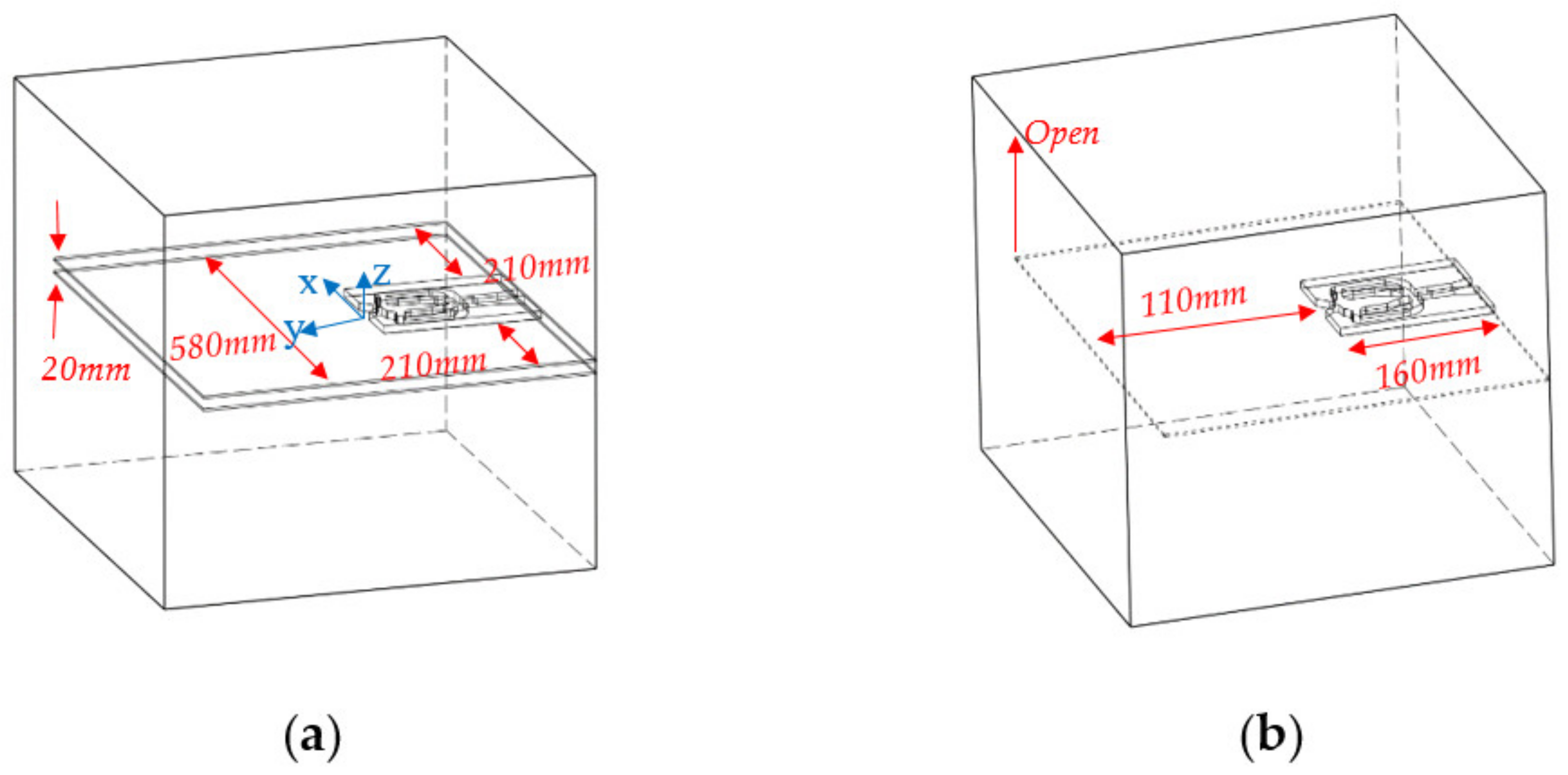
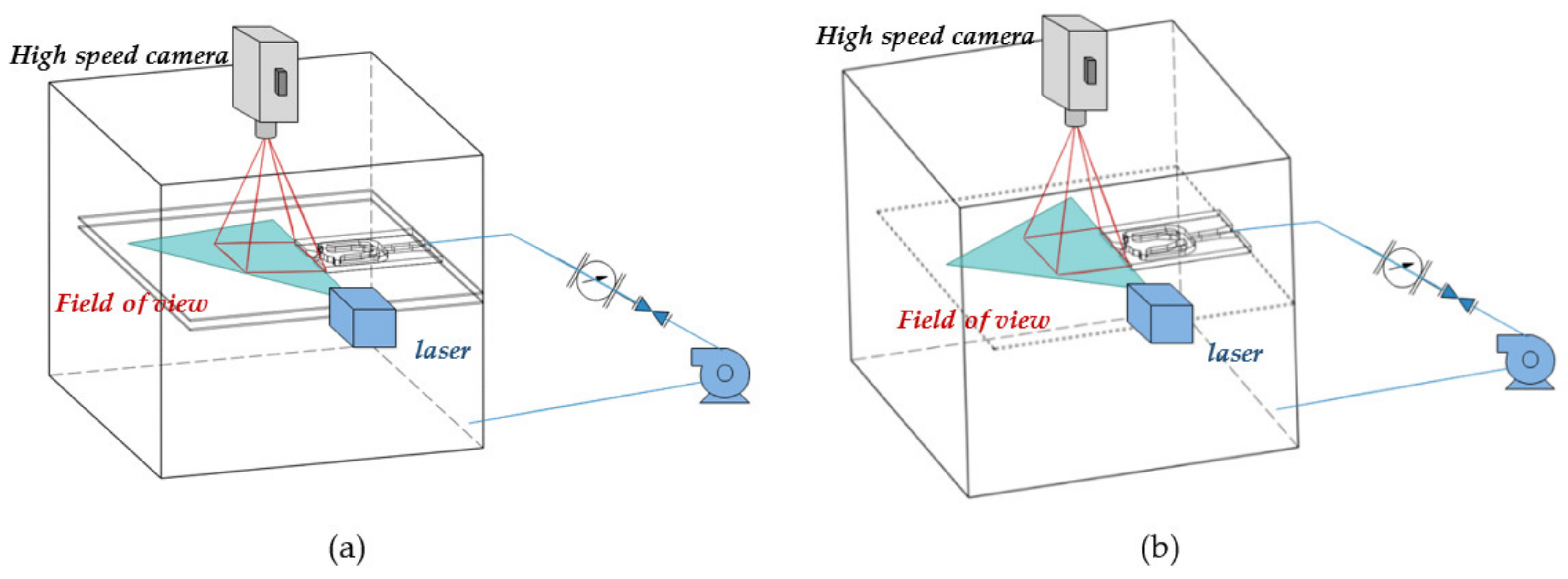
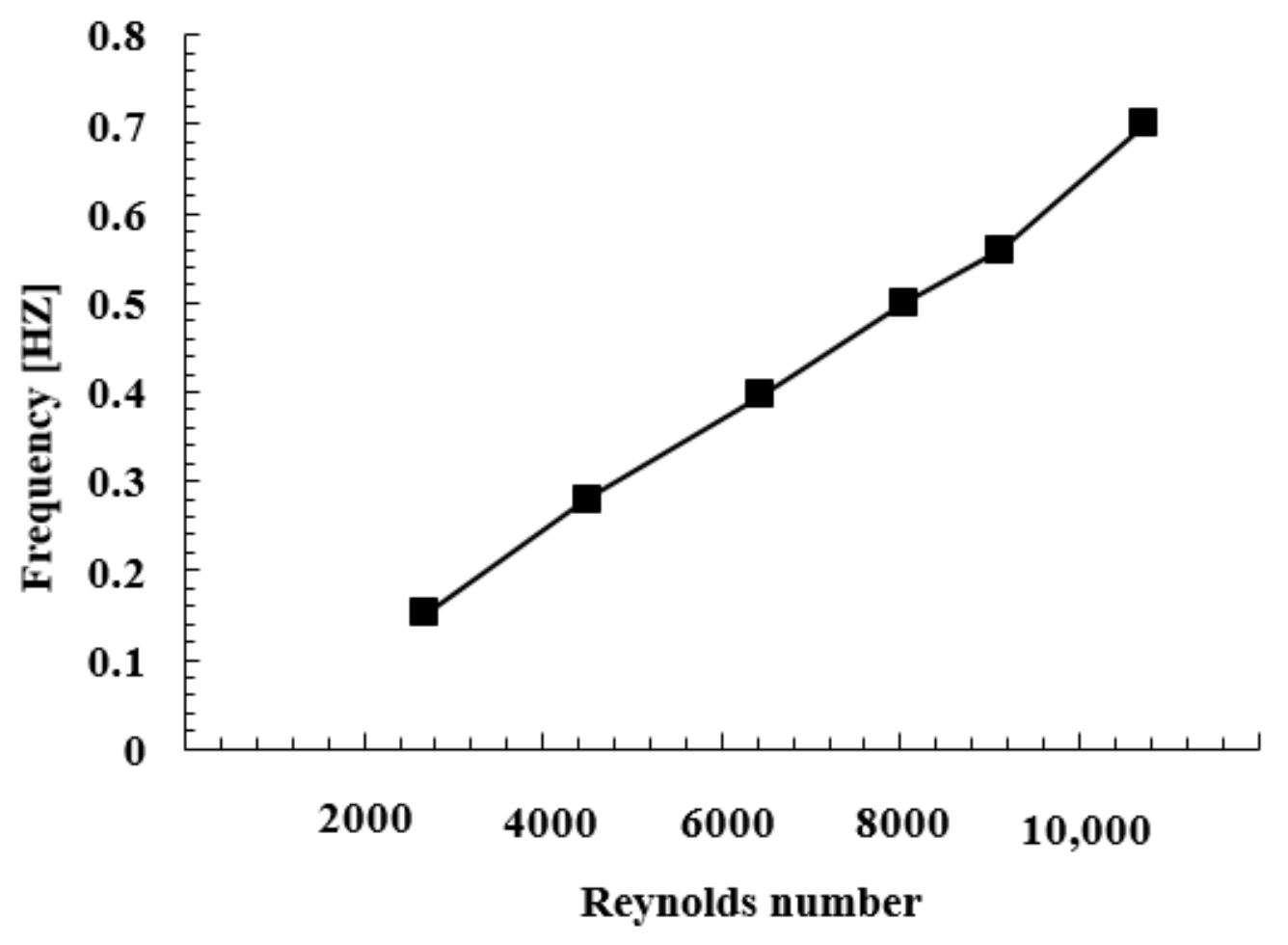
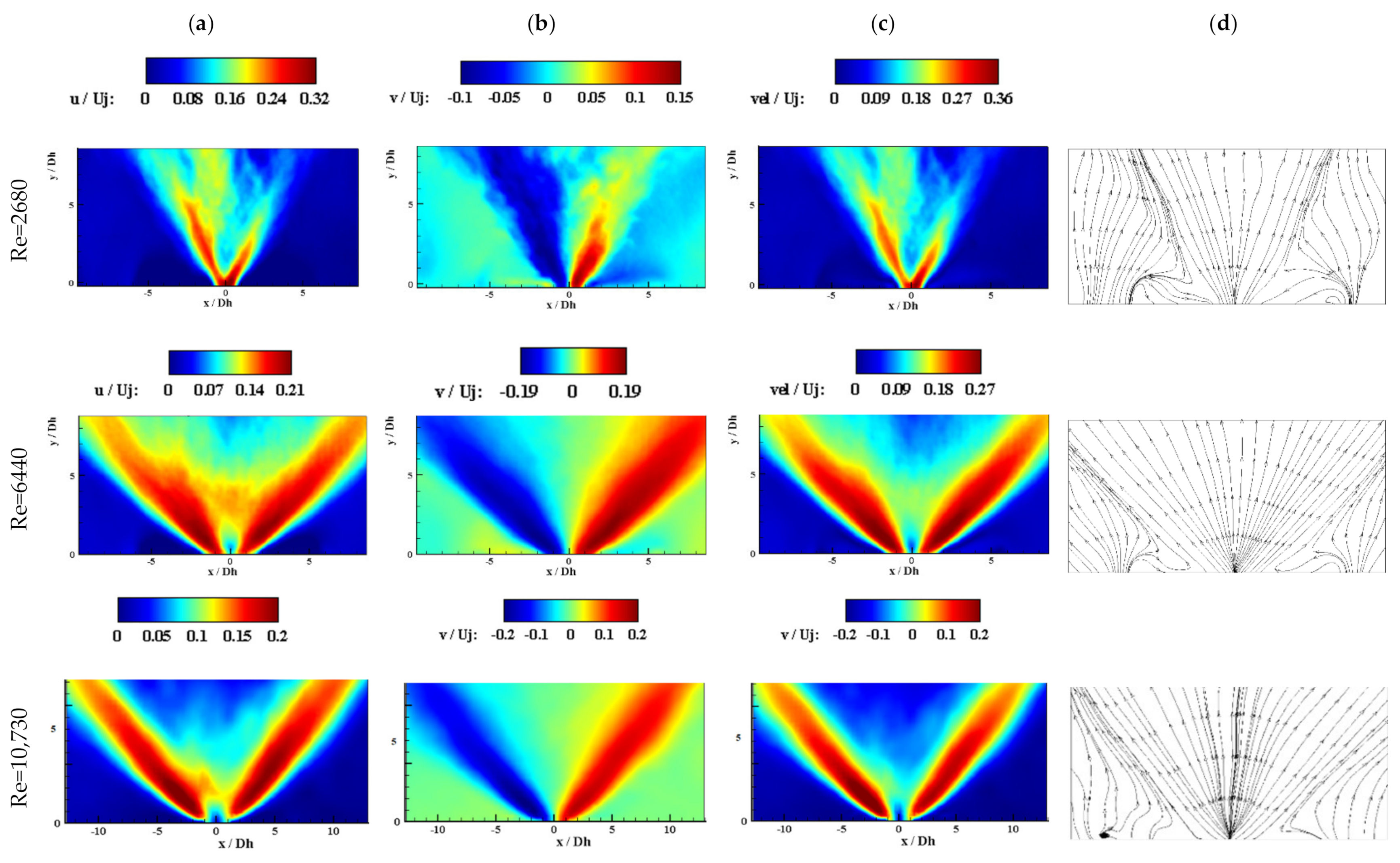
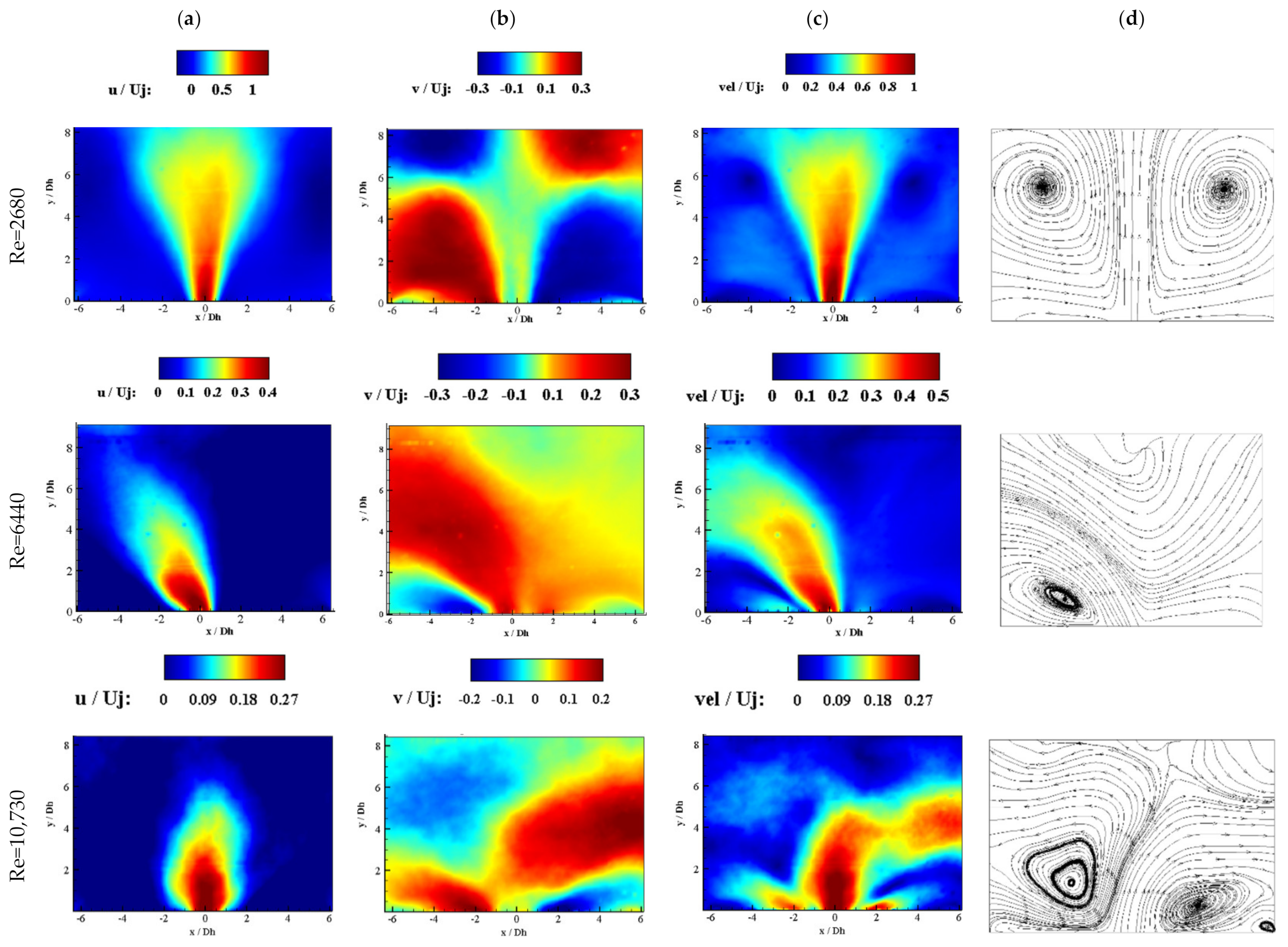

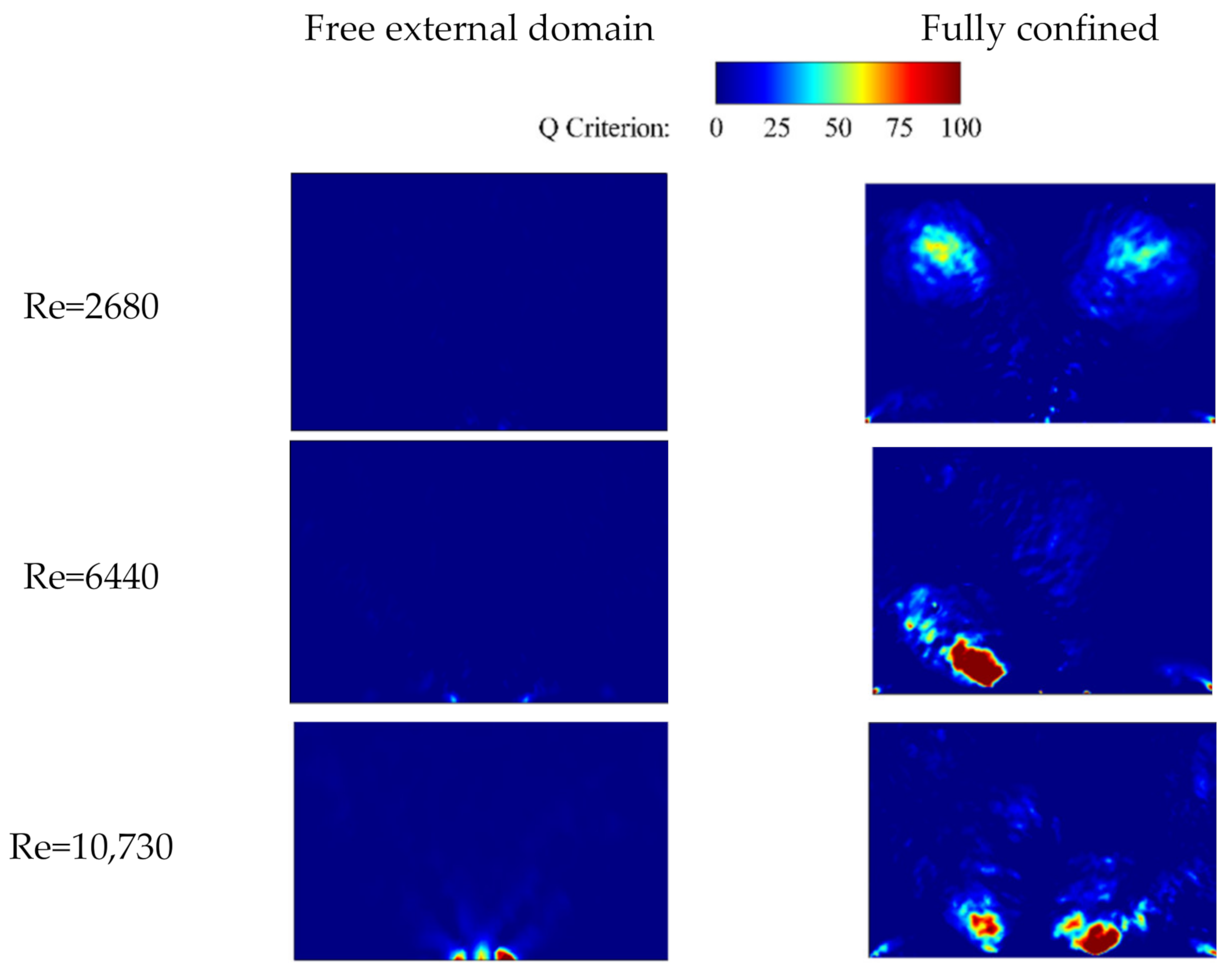

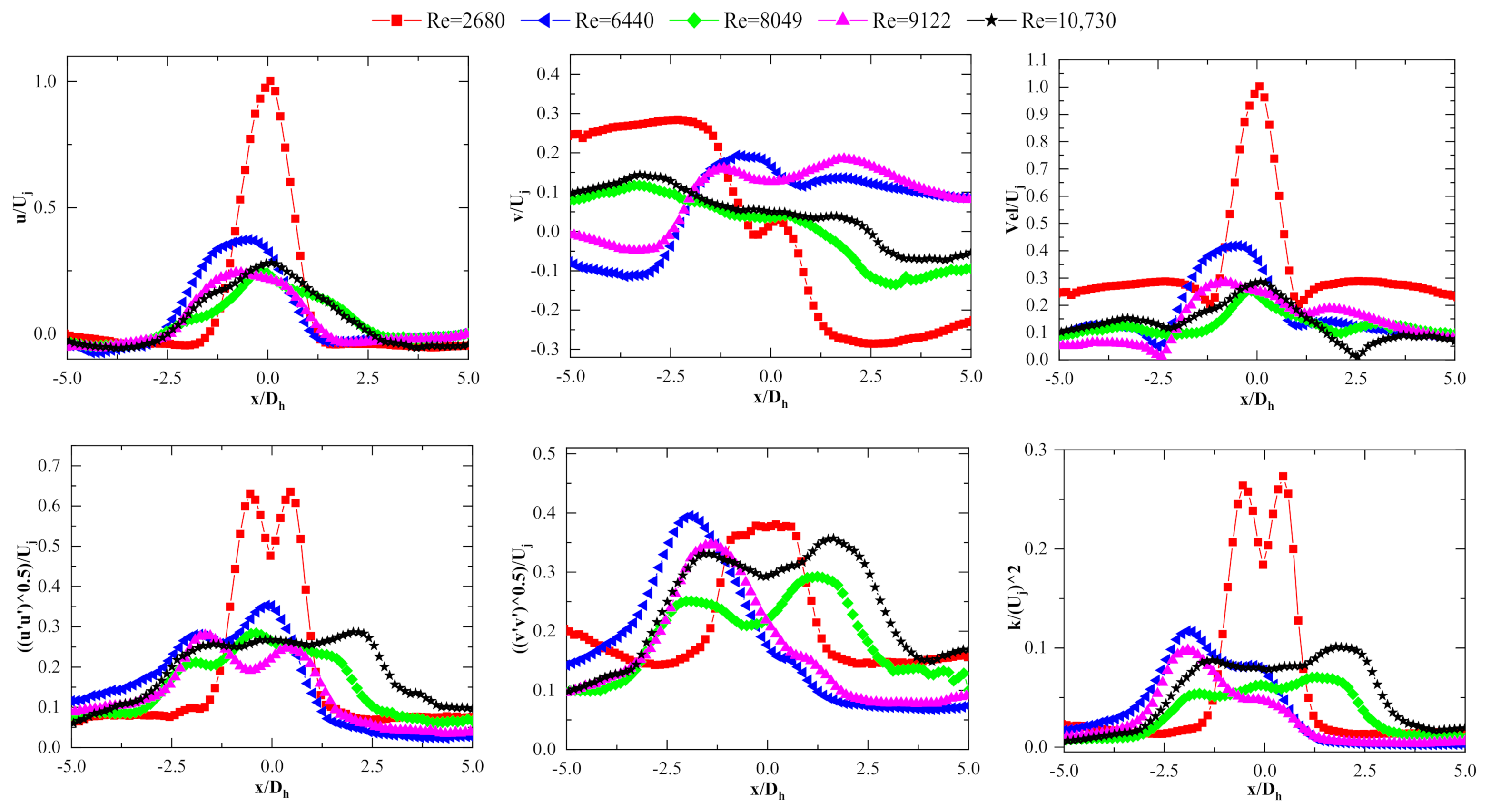


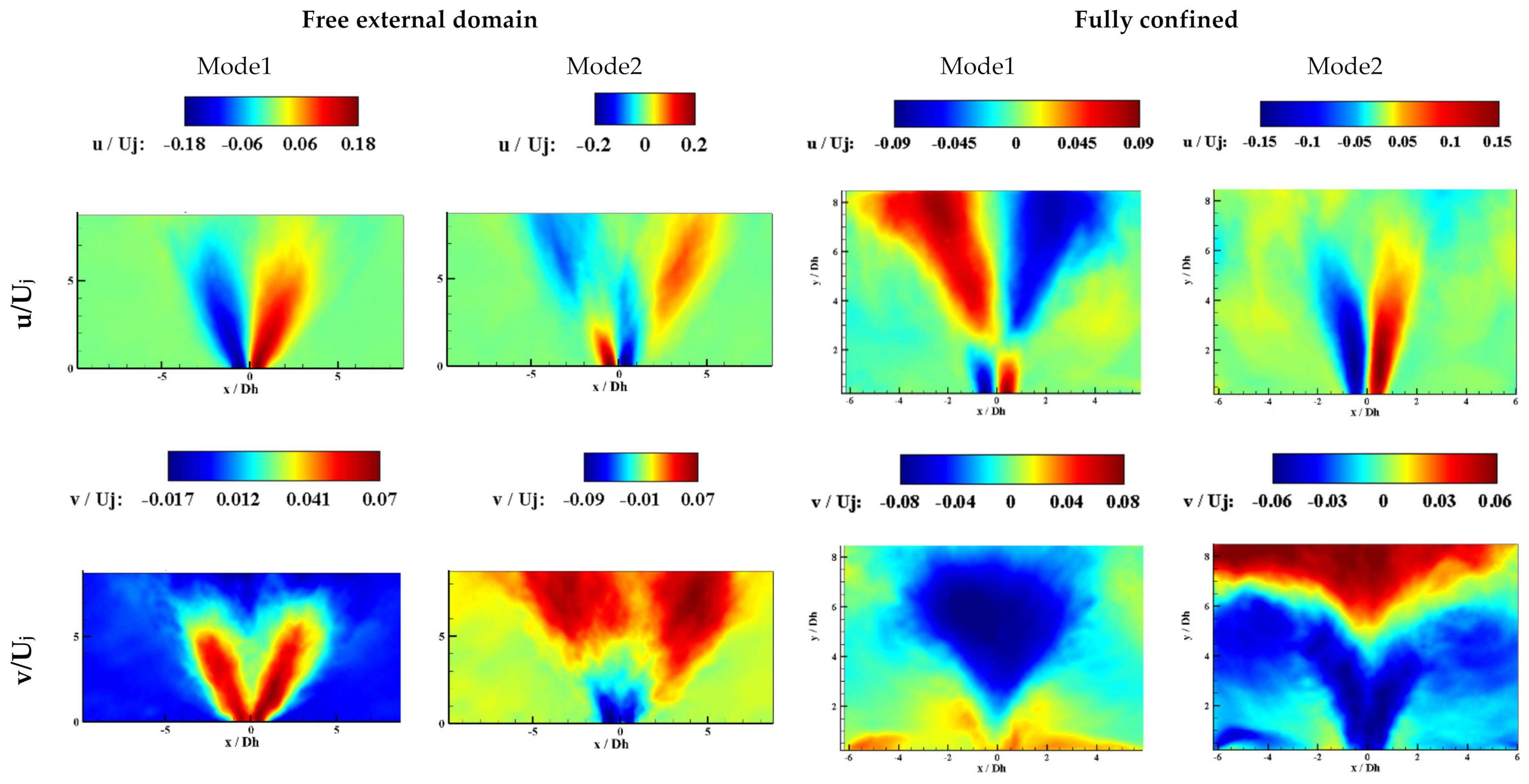
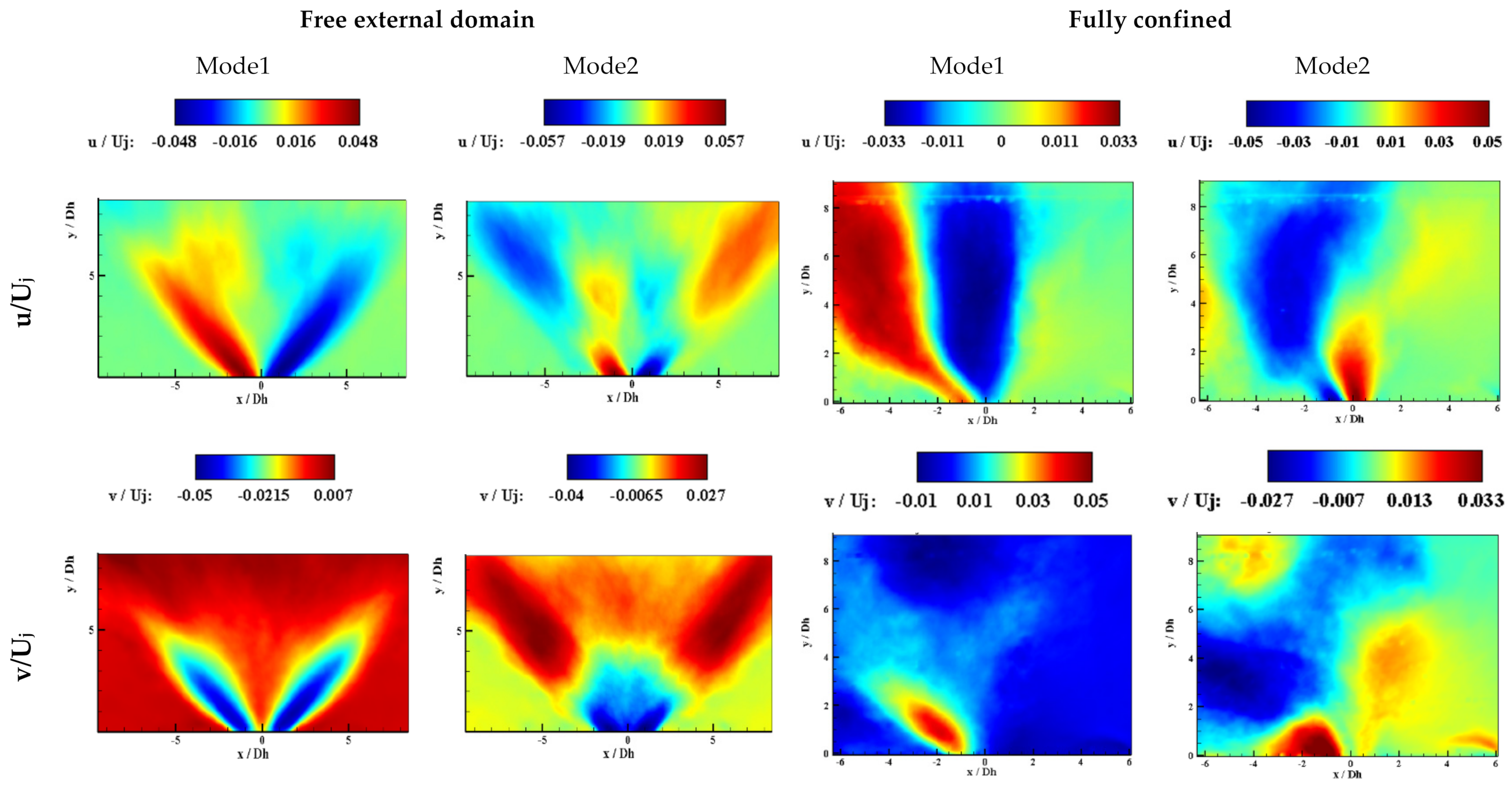
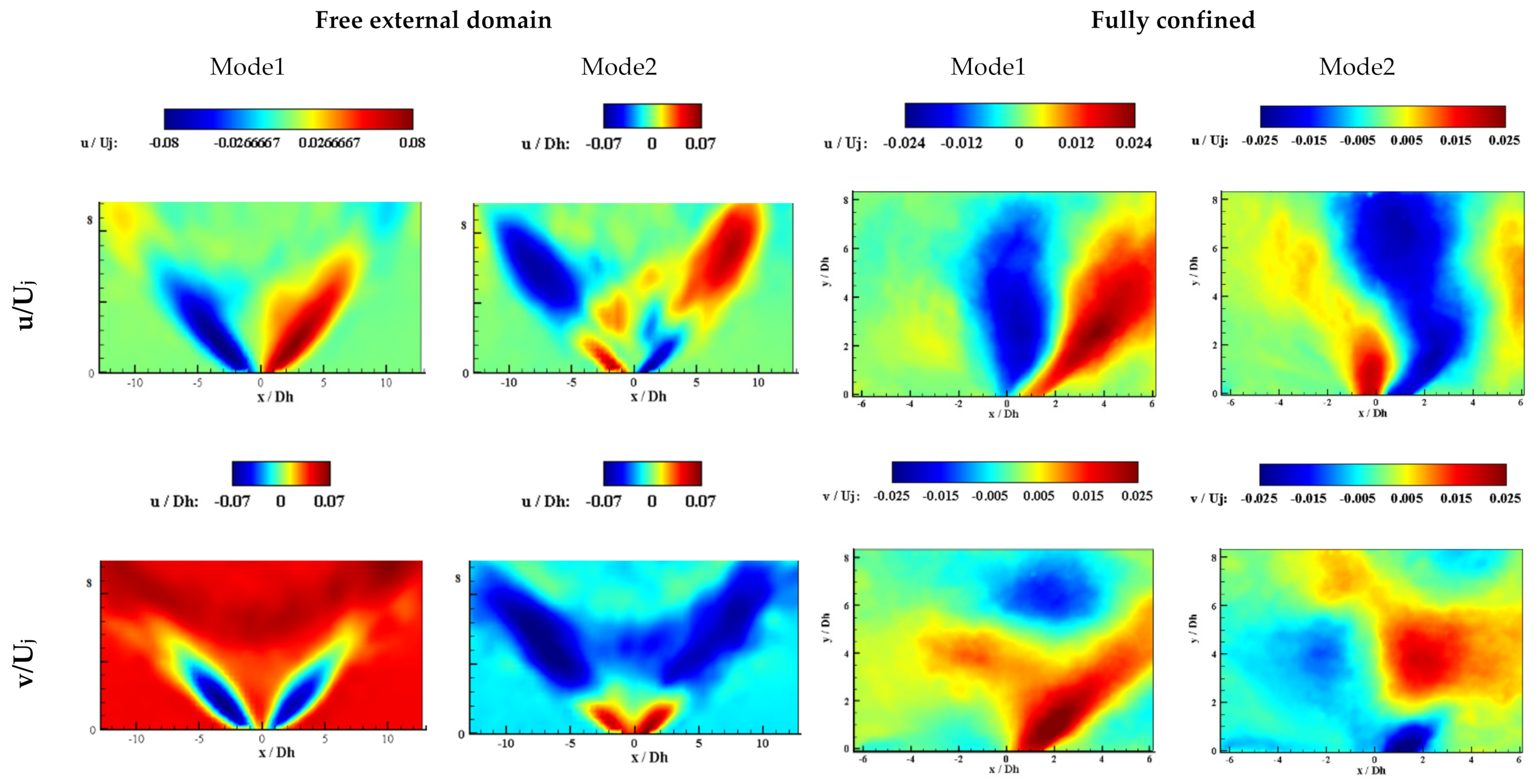
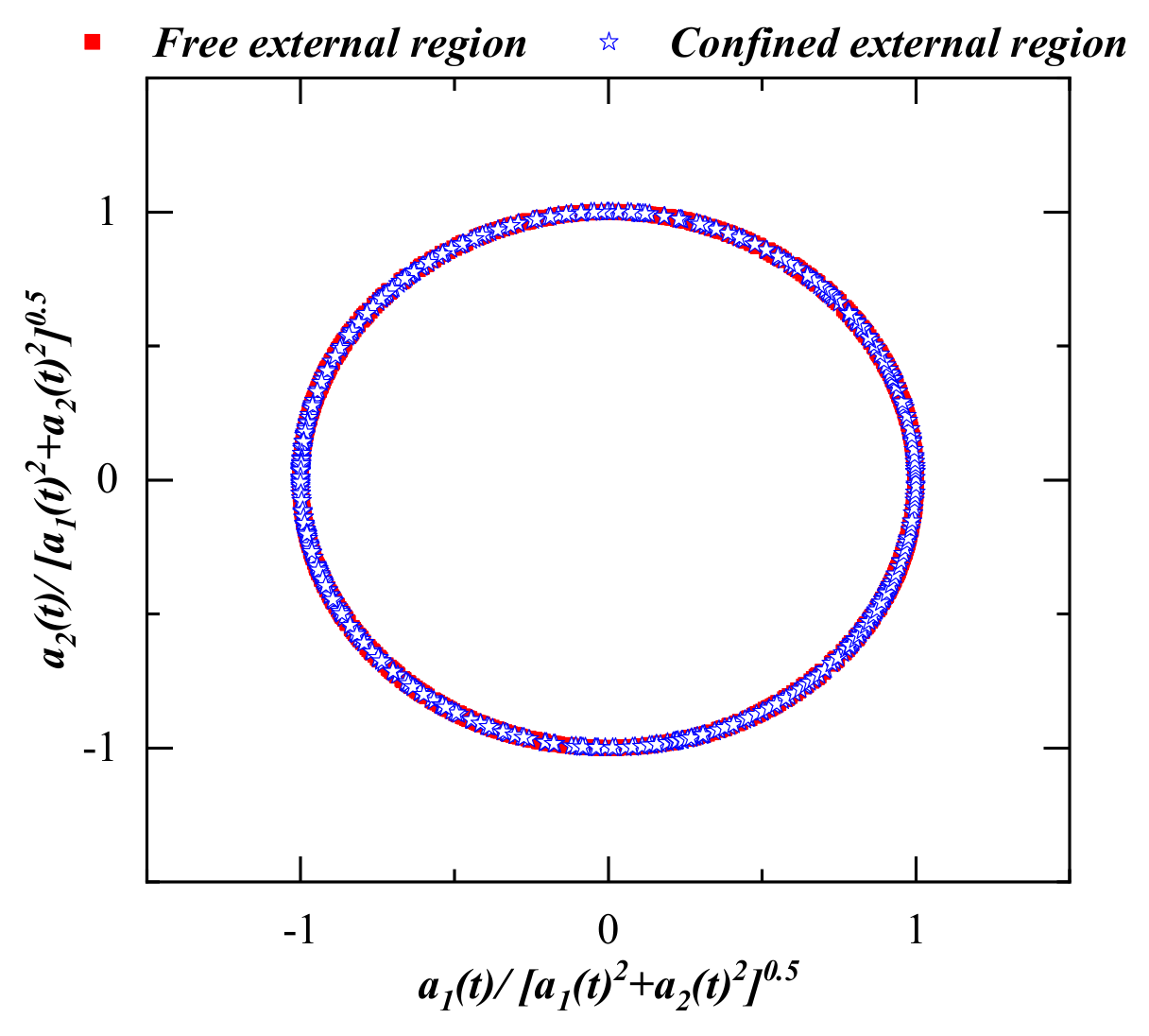
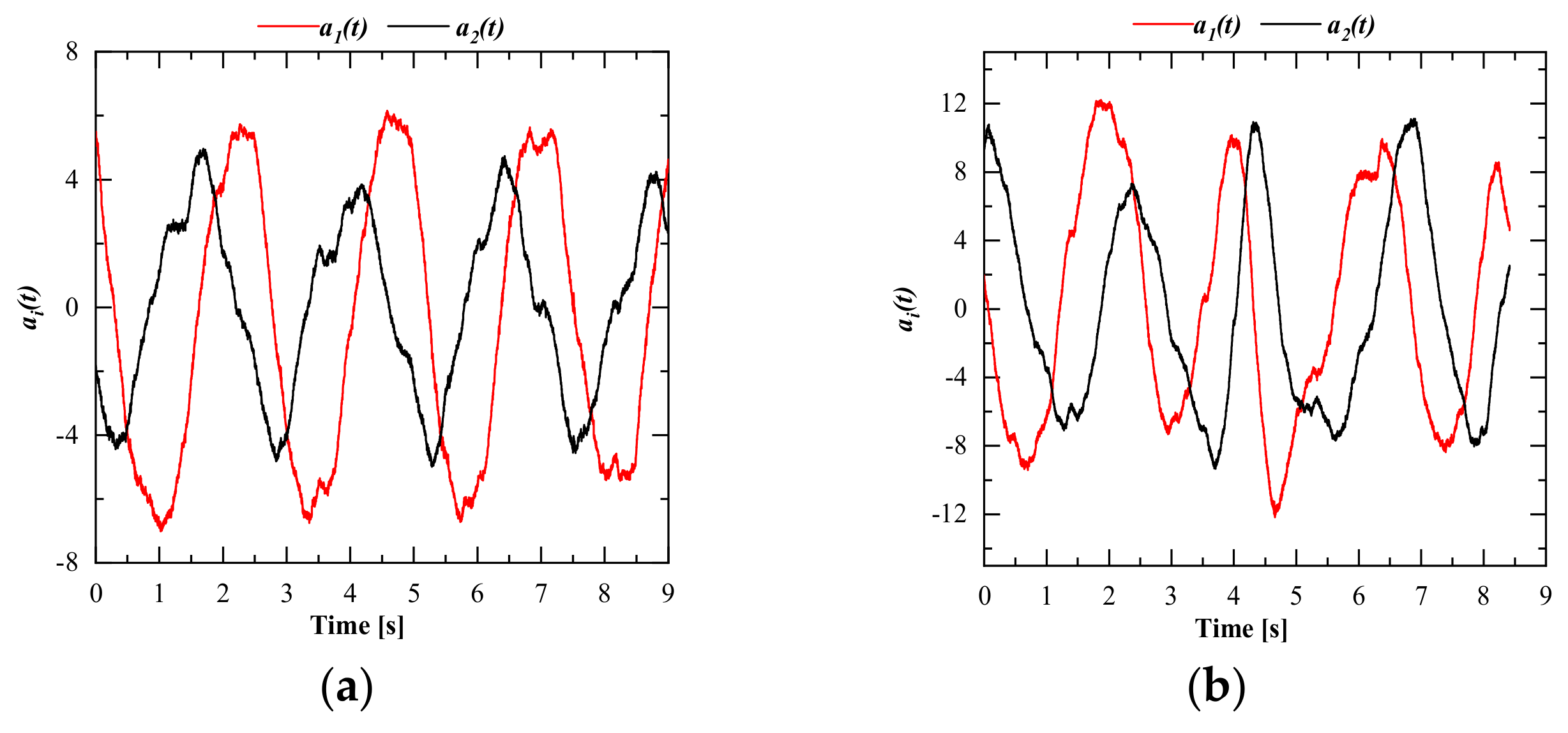


| Free External Domain | Fully Confined | Free External Domain | Fully Confined | |
|---|---|---|---|---|
| Re = 2680 | 1.815 | 13.19 | 3.467 | 0.214 |
| Re = 6440 | 2.031 | 13.28 | 3.339 | 0.510 |
| Re = 10,730 | 2.751 | 13.90 | 4.109 | 0.813 |
| Free External Domain | Fully Confined | |
|---|---|---|
| a1(t) | 0.3968 | 0.4883 |
| a2(t) | 0.3968 | 0.4883 |
| a3(t) | 0.824 | 0.2442 |
| a4(t) | 0.824 | 0.9156 |
Publisher’s Note: MDPI stays neutral with regard to jurisdictional claims in published maps and institutional affiliations. |
© 2020 by the authors. Licensee MDPI, Basel, Switzerland. This article is an open access article distributed under the terms and conditions of the Creative Commons Attribution (CC BY) license (http://creativecommons.org/licenses/by/4.0/).
Share and Cite
Samsam-Khayani, H.; Mohammadshahi, S.; Kim, K.C. Experimental Study on Physical Behavior of Fluidic Oscillator in a Confined Cavity with Sudden Expansion. Appl. Sci. 2020, 10, 8668. https://doi.org/10.3390/app10238668
Samsam-Khayani H, Mohammadshahi S, Kim KC. Experimental Study on Physical Behavior of Fluidic Oscillator in a Confined Cavity with Sudden Expansion. Applied Sciences. 2020; 10(23):8668. https://doi.org/10.3390/app10238668
Chicago/Turabian StyleSamsam-Khayani, Hadi, Shabnam Mohammadshahi, and Kyung Chun Kim. 2020. "Experimental Study on Physical Behavior of Fluidic Oscillator in a Confined Cavity with Sudden Expansion" Applied Sciences 10, no. 23: 8668. https://doi.org/10.3390/app10238668
APA StyleSamsam-Khayani, H., Mohammadshahi, S., & Kim, K. C. (2020). Experimental Study on Physical Behavior of Fluidic Oscillator in a Confined Cavity with Sudden Expansion. Applied Sciences, 10(23), 8668. https://doi.org/10.3390/app10238668






